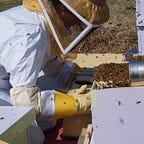Beat the Heat: Giving Bees a Helping Hand This Summer
Keeping Those Hives Temperature Safe
Bees are incredible at regulating temps inside the hive. Maintaining temperatures within a specific range is critical to a beehive’s survival. Optimal temperatures and humidity levels must be controlled for brooding to continue. If the brooding area gets too hot, brooding will cease until temperatures are back between 91–97 degrees Fahrenheit. If brood production halts, hives are at risk of failure. Extremely hot temperatures can destroy colonies. Honey bees may not survive if they can’t regulate the heat in the hive, or they may choose to abscond and find a cooler place to call home. The beekeepers who invest in trying to make the existing location ideal with some extra effort as we approach summer increase the chances of their hives continuing to thrive during the upcoming months.
Provide Honey Bees Water, Shade, Air Flow
There are three things that bees are going to need this summer to get through the hottest months. Plentiful water sources, shade, and airflow are critical to helping bees keep the hive within a healthy range. All living things need water to survive, a crucial supply that bees use for their brood and to create a cooling system inside the hive. Once bees bring droplets of water back to the hive, they use their wings to cool the hive. Bees responsible for bringing food and water back to the hive will continue to bring water back until the need is met. In hot months, when there is no morning dew and shallow water sources dry up quickly, providing clean water sources for bees can be a huge help. Once bees meet the water requirements, they can return to foraging for nectar and pollen.
Hives enjoy the sun’s warming, but when the heat gets extreme, direct and prolonged sun exposure can make regulating the hive temperature challenging. Providing shade to hives during these anticipated scorching days can be incredibly helpful. If hives are not naturally in the shade, an umbrella or shade tent can be used and serve as a temporary source of shade when it is most needed. Good ventilation in the hive is also essential, and ensuring air flows freely can help keep the hive cooler. In some extreme cases, a fan may be used to provide some airflow, but avoid placing hives on hot surfaces and anywhere the airflow would be impeded. Placing hives too close to a wall or structure can prevent steady airflow.
Extreme Temps Call for Extreme Measures
Beekeepers never want to see a beehive suffer and potentially leave the apiary. It is expected that temperatures this summer will continue to break records, and in extreme heat, beekeepers may need to intervene with extreme measures. Using a fan to force air can create some cooling. If hives are not near electrical outlets or it is too difficult to get power to the hives, ice buckets can be placed on the top of the box, and beekeepers can also place wet towels on the hive box lid without obstructing the bee’s access. Using towels is an excellent way to help hives regulate temperatures in extreme heat, but they must be rewet periodically. Towels and a fan — presto! A cooled hive in extreme heat.
Although it is always best to allow bees to adapt and regulate independently, these measures can be used in an emergency. Heat waves can concern beekeepers, especially if bees seem disoriented or cluster outside the hive. These are both indications of the beehive being too hot or overcrowded, and bees may swarm to find a new home. When temperatures are expected to be in the triple digits for several days, providing assistance can help. Otherwise, let the bees figure it out — when they do it on their own, it is better for the sustainability of the colony.
Although bees are incredibly capable, motivated, and dedicated, there is only so much they can do when the temperatures are extreme. Summer is likely to bring some scorching days, weeks, and months, and beekeepers would be wise to take some measures to help bees out this summer. As we move into the hot summer months, beekeepers would be wise to prepare for the anticipated temperatures. It is always better to be prepared than to scramble when the temperatures are so hot when it is hard to get your hands on the things you need, like fans, shade tents, etc. Basically, bees need the same things people do in hot weather. Shade from the sun’s direct rays, plenty of water to hydrate and stay cool, and steady airflow. Check with a local beekeeper if you have questions or concerns about bees and bee activity in your area.
